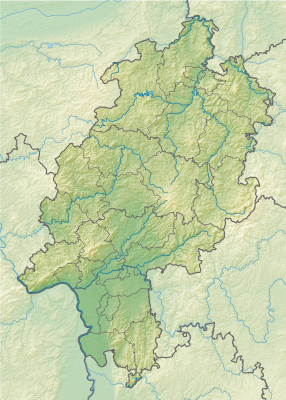Old Schanz (Heidenrod)
| Old Schanz | ||
|---|---|---|
|
Western area of the complex with ramparts and moats |
||
| Alternative name (s): | Alteschanz, Zorner Schanze | |
| Creation time : | probably early Middle Ages | |
| Castle type : | Hill castle, moth | |
| Conservation status: | Burgstall, ground monument | |
| Standing position : | probably a safe haven | |
| Place: | Heidenrod - anger | |
| Geographical location | 50 ° 9 '13.4 " N , 7 ° 54' 56.1" E | |
| Height: | 465 m above sea level NN | |
|
|
||
The Alte Schanz is a disused ring wall south of Heidenrod - Zorn im Taunus in Hesse . The facility has not yet been explored in depth.
Location and description
The Alte Schanz is located approx. 600 m south of Zorn in a wooded area in the area of a conservation area called Struthheck . Here it borders on a burial mound field, which has almost 40 graves. It is incorrectly entered as a burial mound on the topographic map 5813 Nastätten . The hill is the northernmost of the graves registered here.
The system itself has a diameter of 18 m, with a circular shape. The wall towers above the existing trench floor by 1.5 m to 3.0 m. The trench itself is about 7.0 m wide. The floor inside the rampart is about 0.3 m higher than the natural floor. The wall is raised by 0.2 m to 1.3 m compared to the inner floor.
It can be assumed that a bridge was built as an entrance. It is unlikely that there was a masonry wall. Rather, a wooden fence is to be assumed.
As part of the development with the Zorner Runde hiking trail , a wooden access walkway was laid across the ditch in the north.
Lying in the direction of Zorn, Karl August von Cohausen found iron slag heaps near the Alte Schanz. To the northwest of the plant there is a several hectare mining area for loam and clay.
Historical classification
No explorations have been carried out at the Alte Schanz to date, which is why the dating of the facility can only be carried out under theoretical aspects.
Fritz-Rudolf Herrmann assigns the ski jump to modern times. There is also the theory that the complex is related to the Austro-Prussian War and the Battle of Zorn . Due to the age of the trees growing in the hill (around 1812), as well as the shape of the facility itself (no floor-level access and no possibility for pre-loaded guns to maneuver), the connection with the Battle of Zorn is extremely unlikely.
Karl August von Cohausen compares the Alte Schanz with the Drusenküppel , an early to high medieval tower hill castle (Motte) near Obernhain . This interpretation seems more likely. The construction of the Alte Schanz is an early to high medieval tower castle . This type of construction originated at the end of the early Middle Ages. During the reign of King Henry I of Saxony , numerous tower castles were built in inaccessible forest and swamp areas to protect the population from the Hungarians threatening the empire. The district name Struthheck indicates such an origin . Struth can be derived from the Old High German word Struot, which means a swamp area. The former district archaeologist Dr. Pachali assigned the Alte Schanz to this time. Current research by the Geographical Institute of the University of Mainz revealed pieces of charcoal from the 10th century in and around the facility.
The popular idea of the Alte Schanz among the local population is that the complex is a royal tomb. However, this is a misinterpretation in terms of appearance, whereby it cannot be ruled out that a grave was integrated when the facility was built.
Monument protection
The area of the ramparts as well as the burial ground is a ground monument according to the Hessian Monument Protection Act . Investigations and targeted collection of finds are subject to approval, and accidental finds are reported to the monument authorities.
swell
- Topographic map 5813 Nastätten , published by the Hessian State Office for Soil Management and Geoinformation
- Karl August von Cohausen Landwehren and old entrenchments of the administrative district Wiesbaden in Nassauische Annalen 15 (1879)
- Fritz-Rudolf Herrmann , Albrecht Jockenhövel: The prehistory of Hesse . Konrad Theiss Verlag, Stuttgart 1990, ISBN 3-8062-0458-6
Web links
Individual evidence
- ↑ Alte Schanz at Burg Direkt
- ^ Fritz-Rudolf Herrmann, Albrecht Jockenhövel: The prehistory of Hesse . P. 404.
- ↑ Landwehr and old entrenchments of the administrative district Wiesbaden in Nassauische Annalen 15 (1879) p. 362 ff
- ↑ Homepage of the Heimatverein Heidenrod







